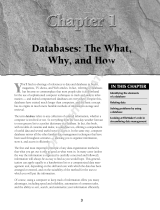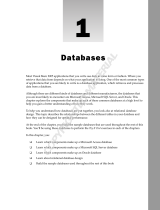
8 FileMaker ODBC and JDBC Guide
SQL is passed through the ODBC and JDBC interfaces to the FileMaker host of the data source, performing
queries such as
SELECT first_name, last_name FROM customers WHERE city='Paris' and
making updates such as the creation of a new record with
INSERT INTO customers (first_name,
last_name) VALUES ('Jane','Smith')
.
Accessing a hosted FileMaker Pro database
With either FileMaker Server Advanced or FileMaker Pro, you can host a FileMaker database file as a data
source, sharing your data with other applications using ODBC and JDBC. The following table describes
what each FileMaker product allows.
The ODBC and JDBC plug-in components you need for sharing your data with other applications is
installed with FileMaker
Server Advanced and FileMaker Pro.
To access a hosted FileMaker database file, you need to install the corresponding ODBC or JDBC client
driver. Install the client driver on the machine on which the third-party application is installed. See
chapter 2,
“Installing FileMaker ODBC and JDBC client drivers” for information on installing the driver files needed
for accessing a FileMaker data source.
If your FileMaker database solution uses more than one FileMaker database file, all of the database files
must be on the same computer.
Chapter 5, “Supported standards,” describes the SQL statements that the ODBC and JDBC client drivers
support when used with FileMaker Pro and FileMaker Server Advanced.
Important If you disable ODBC/JDBC sharing after it's already been on, a data source hosted by
FileMaker
Server Advanced or FileMaker Pro immediately becomes unavailable. The database
administrator doesn’t have the capability to alert ODBC and JDBC client applications about the data
source’s availability (the administrator can communicate only with FileMaker database file clients). No
errors are reported, and the client application should notify users that the data source is not available and
transactions cannot be completed. If a client application attempts to connect to an unavailable FileMaker
database file, a message explains that the connection failed.
Limitations with third-party tools
1 Microsoft Query Wizard: In a FileMaker data source, you cannot access table or column names that use
High ASCII or double-byte characters. Instead, use Microsoft Query and manually enter the characters,
enclosed in double quotation marks.
1 Microsoft Access: In a FileMaker data source, you cannot access table or column names that use High
ASCII or double-byte characters.
Networking requirements
You need a TCP/IP network when using FileMaker Server Advanced to host a FileMaker database file as a
data source over a network. FileMaker
Pro supports local access (same computer) only.
This FileMaker product Allows
FileMaker Server Advanced
Up to 50 connections and supports local access (same computer) and remote
access (both for middleware such as web servers, and for remote client access
from desktop productivity applications).
FileMaker Pro
Up to nine connections and supports local access (same computer) only.




























